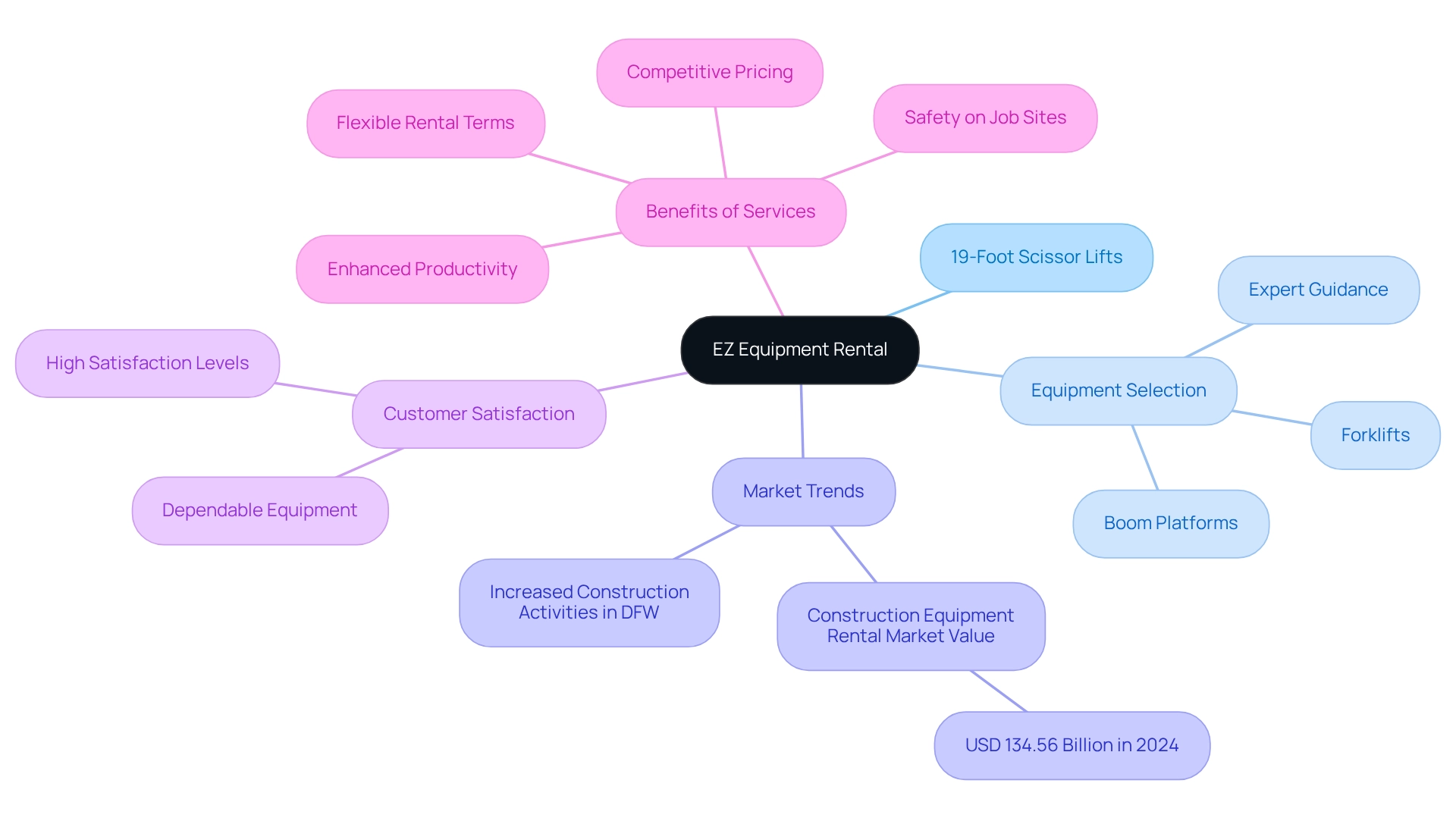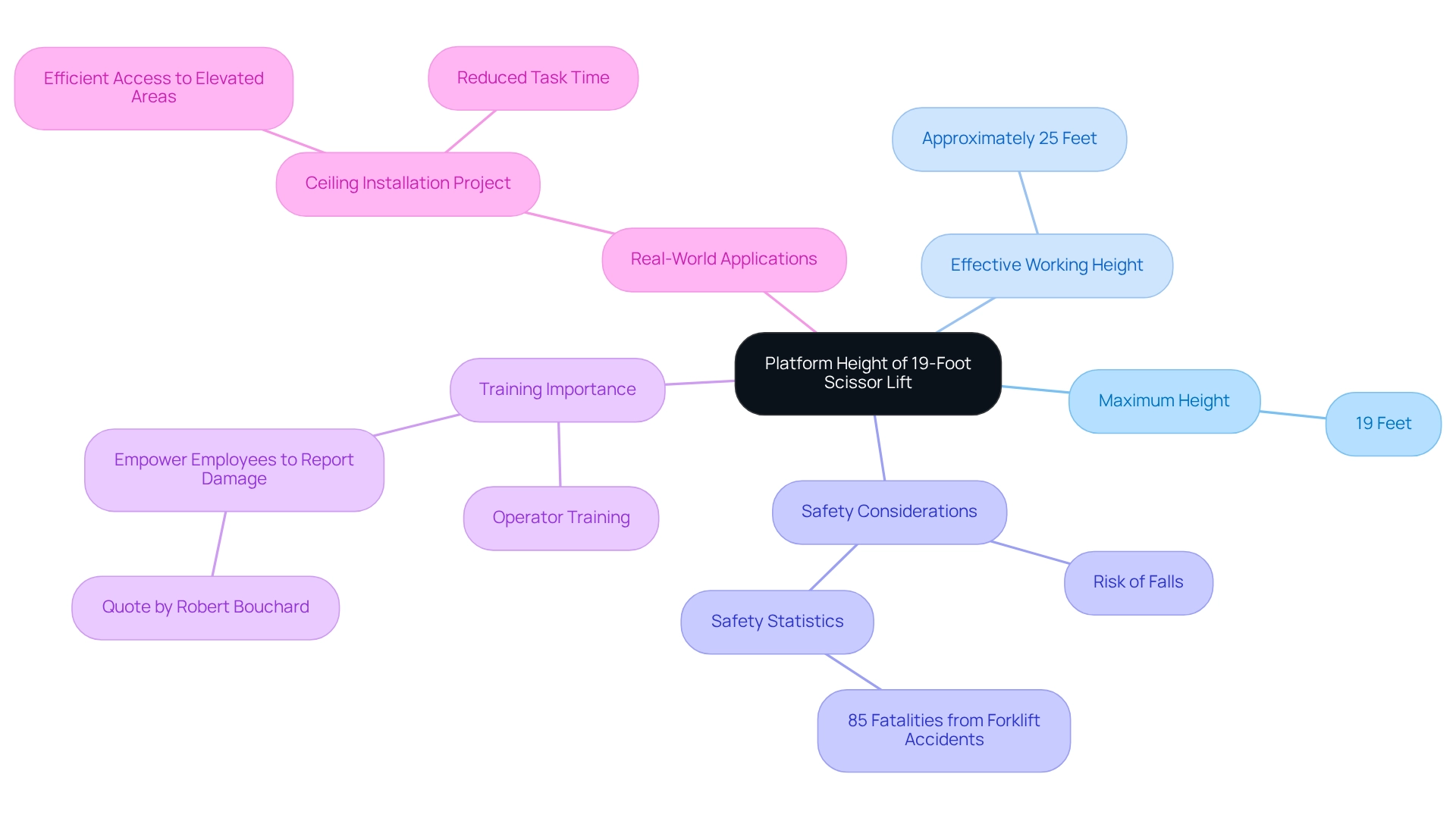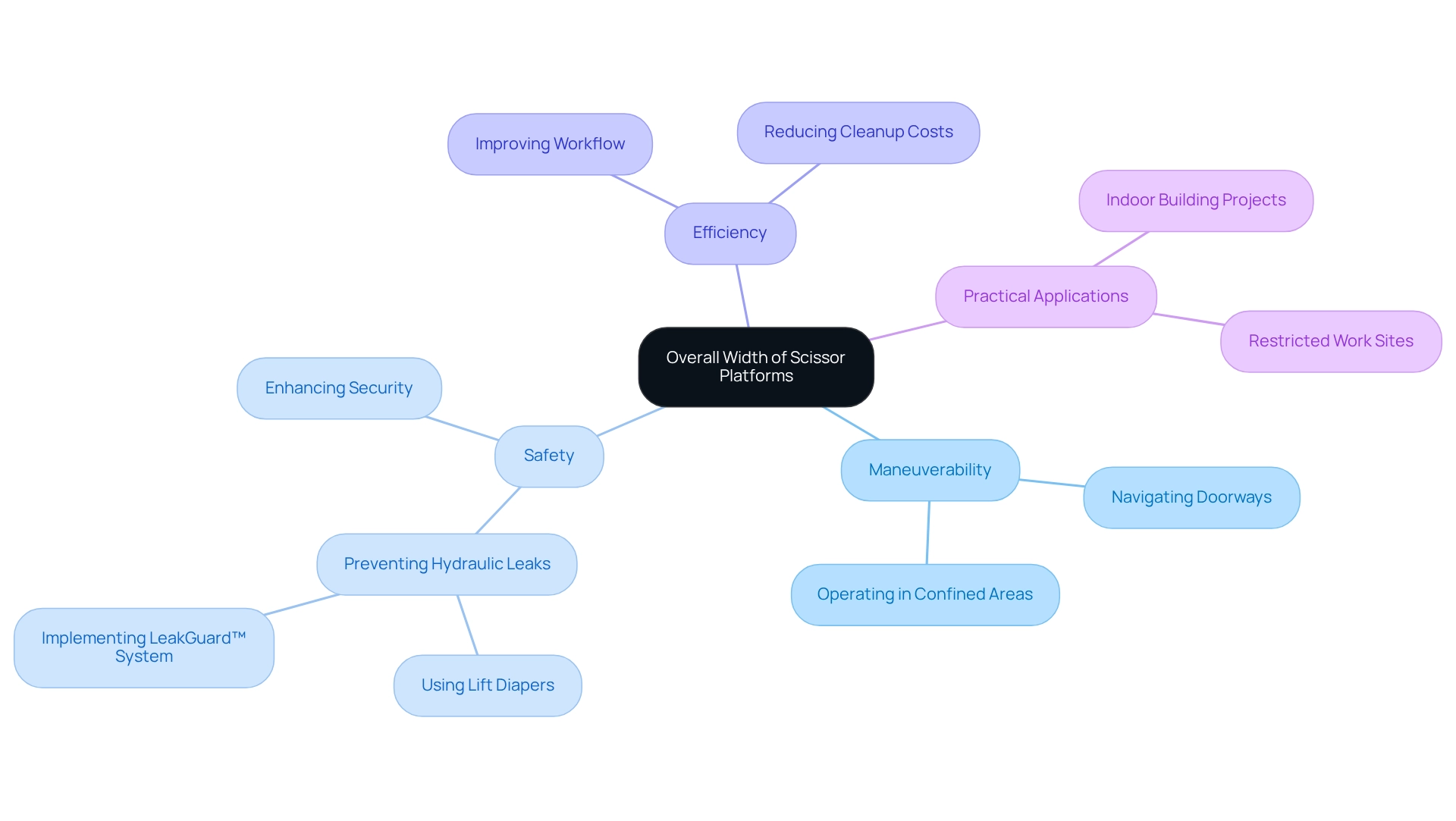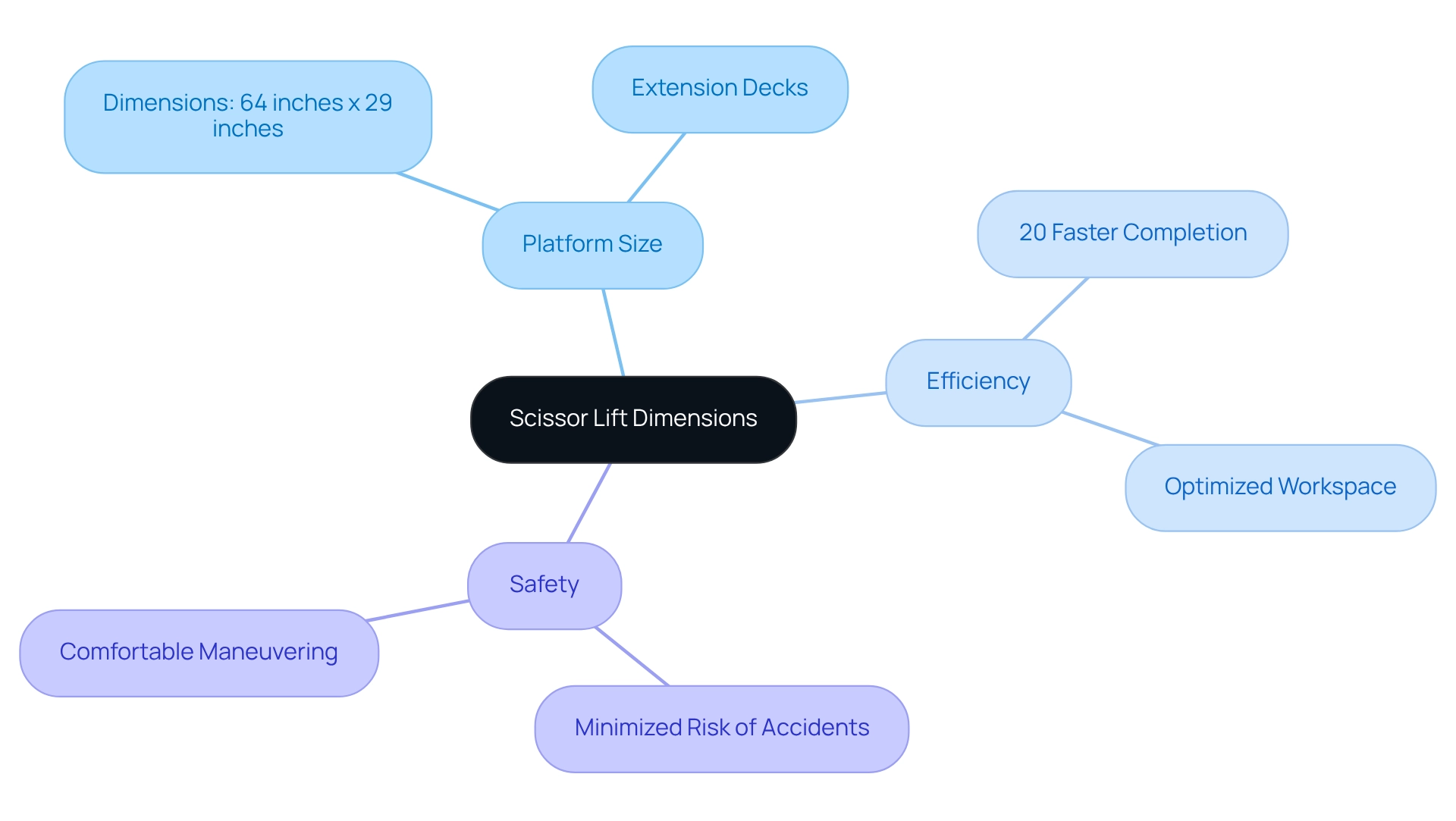Overview
This article delves into the key dimensions of 19-foot scissor lifts that are vital for construction projects. It highlights the importance of specifications such as:
- Platform height
- Overall width
- Load capacity
- Platform dimensions
These factors are crucial for ensuring safety and efficiency on job sites, as they directly influence maneuverability, operational limits, and productivity. Furthermore, industry insights and real-world applications underscore the significance of adhering to these dimensions for successful project execution.
Key Highlights:
- EZ Equipment Rental is a leading provider of 19-foot scissor lift rentals in the Dallas-Fort Worth area, catering to diverse construction needs.
- The Construction Equipment Rental Market is projected to reach USD 134.56 billion in 2024, indicating strong industry growth.
- Customer satisfaction is high due to reliable equipment and expert guidance in choosing the right machinery.
- The 19-foot scissor lift provides a maximum platform height of 19 feet, essential for tasks like ceiling installations and maintenance.
- Safety training is critical for operators to mitigate risks associated with working at heights.
- The overall width of 19-foot scissor lifts allows for maneuverability in tight spaces, crucial for indoor projects.
- Load capacity typically ranges from 500 to 1,000 pounds, with adherence to these limits vital for safe operation.
- Larger platform dimensions enhance productivity and safety by providing more workspace for operators.
- EZ Equipment Rental offers flexible rental terms and competitive pricing, supporting project efficiency in the DFW metro area.
Introduction
In the dynamic construction landscape of the Dallas-Fort Worth area, the demand for reliable equipment has reached unprecedented levels, particularly for 19-foot scissor lifts. EZ Equipment Rental stands out as a premier provider, offering a diverse array of high-quality lifts tailored to meet the unique requirements of various projects, ranging from routine maintenance to extensive installations.
By prioritizing customer satisfaction and delivering expert guidance, EZ Equipment Rental simplifies the rental process, ensuring clients have access to dependable machinery—an essential factor for enhancing productivity and maintaining safety on job sites.
As the construction equipment rental market continues to expand, it becomes increasingly vital for project managers to understand the specifications and advantages of scissor lifts to optimize efficiency and safety in their operations.
EZ Equipment Rental: Your Source for 19-Foot Scissor Lift Rentals
EZ Equipment Rental stands as the premier provider of aerial platform rentals featuring 19 scissor lift dimensions in the Dallas-Fort Worth region. Their extensive selection of high-quality elevating platforms, along with an array of machinery such as boom platforms and forklifts, is meticulously crafted to meet the diverse demands of construction projects—ranging from routine maintenance tasks to large-scale setups. Committed to client satisfaction, EZ Equipment Rental ensures that customers receive expert guidance in selecting the right equipment for their specific needs, facilitating a seamless and efficient rental experience.
The demand for aerial platforms has surged, reflecting broader trends within the construction industry. In 2024, the Construction Equipment Rental Market was estimated to be valued at USD 134.56 billion, showcasing robust growth. This trend is evident in the Dallas-Fort Worth area, where construction activities have experienced significant upticks. Customers consistently report high levels of satisfaction with EZ Equipment Rental's services, highlighting the critical role of dependable equipment in the successful execution of projects. Their commitment to reliability guarantees that all machinery, including elevating platforms, undergoes regular maintenance, significantly reducing the likelihood of failures during crucial operations.
Construction supervisors emphasize that access to reliable elevating platforms not only enhances productivity but also ensures safety on job sites. With flexible rental terms and competitive pricing, coupled with features such as easy maneuverability and impressive lifting capacity, EZ Equipment Rental is devoted to providing optimal solutions for all construction needs. This dedication positions them as the preferred choice for elevating platform rentals in .

Platform Height: Key Dimension of the 19-Foot Scissor Lift
The platform height, one of the 19 scissor lift dimensions, is a critical specification that determines the maximum elevation at which workers can operate safely. Typically, these lifts provide a maximum platform height of 19 feet, translating to an effective working height of approximately 25 feet. This height is particularly beneficial for tasks such as ceiling installations, electrical work, and maintenance activities that require access to elevated areas.
Recognizing the significance of platform height is essential for ensuring safety on construction sites. Working at heights increases the risk of falls, which are a leading cause of workplace injuries. Safety standards mandate that operators must be trained to understand the limitations and capabilities of the equipment they utilize. As Robert Bouchard, a Damotech rack specialist, emphasizes, "Train your employees on rack security and they’ll identify and report the damage. Empower them to report damage and you’ll avoid accidents."
Real-world applications of the 19 scissor lift dimensions demonstrate their effectiveness in various construction scenarios. For example, during a recent ceiling installation project, a construction team utilized a 19-foot aerial platform to efficiently access elevated areas, significantly reducing the time required for the task while adhering to safety guidelines.
Furthermore, safety statistics underscore the importance of complying with platform height regulations. With forklift incidents resulting in approximately 85 fatalities each year, it is vital to emphasize proper training and awareness regarding equipment operation, including elevating platforms, as both involve working at heights. —such as likelihood, impact, velocity, and connectivity—further highlight the dangers associated with elevated work environments. Experts assert that encouraging employees to voice concerns about safety can lead to a more secure workplace.
In conclusion, the 19 scissor lift dimensions, specifically the platform height of a 19-foot elevating device, are not just measurements; they are pivotal factors that influence operational efficiency and safety in construction projects.

Overall Width: Essential Measurement for Job Site Maneuverability
The overall width of a 19-foot scissor platform is part of the 19 scissor lift dimensions and typically ranges from 2 feet 8 inches to 3 feet, depending on the model. This compact design is crucial for navigating standard doorways and narrow aisles, making these devices ideal for indoor building projects and restricted work sites. Evaluating the 19 scissor lift dimensions is vital for maintaining workflow and productivity, as these dimensions directly impact maneuverability in challenging spaces.
Statistics reveal that maneuverability issues are a significant concern on construction sites, with project managers highlighting the necessity for equipment that can operate efficiently in confined areas. Bob Begley, Director of Product Management – Scissor Elevators at JLG, asserts, "With the ES1930M, JLG is prepared to enter and dominate in the growing ‘micro’ platform category, providing a machine specifically designed for real-world work-at-height challenges."
By selecting a platform with the appropriate width, teams can enhance security and efficiency, leading to smoother project execution. Furthermore, well-constructed elevating devices help prevent issues such as hydraulic fluid leaks, which can damage finished floors and incur substantial cleanup costs. This underscores the importance of choosing the 19 scissor lift dimensions that not only suit the job site but also mitigate potential risks.
The investment in aerial work platforms is justified by the increased efficiency and safety they offer at job sites, further highlighting the critical role of maneuverability in achieving project success.

Load Capacity: Understanding Weight Limits for Safe Operation
The load capacity of a 19-foot elevating platform typically ranges from 500 to 1,000 pounds, depending on the model. This capacity encompasses the combined weight of the operator, tools, and materials being lifted. Comprehending and adhering to these weight restrictions is crucial for safe operation, as exceeding them can significantly compromise the stability of the apparatus and increase the likelihood of accidents.
Statistics on safety indicate that overloading scissor lifts is a leading cause of workplace incidents, underscoring the necessity for operators to regularly review protocols and remain vigilant. For example, a case study on workplace safety emphasizes that investing in protective measures can yield substantial cost savings by preventing accidents and injuries. In fact, organizations that prioritize safety often observe a reduction in expenses related to workplace incidents, reinforcing the economic advantages of adhering to strict load capacity guidelines.
Moreover, experts stress the importance of , which are designed to protect both operators and equipment. Accidents resulting from overloading can lead to severe injuries and significant financial repercussions. For instance, documented cases have shown that overloading scissor lifts has resulted in catastrophic failures, leading to injuries that could have been avoided with proper adherence to weight limits. This highlights the imperative for construction project managers to prioritize weight limits in their operational protocols.
As Bob Chapman aptly stated, "The greatest responsibility of a leader is to give the people in your span of care grounded sense of hope for the future." By fostering a culture of safety and compliance, organizations can enhance their overall financial well-being while protecting their workforce.

Platform Dimensions: Maximizing Efficiency and Safety on the Job
indicate that the platform of a 19-foot elevating device typically measures around 64 inches by 29 inches, providing ample space for operators to work efficiently. Many models come equipped with extension decks, which further expand the working area, enabling the simultaneous use of additional tools and materials. This increased platform size not only boosts productivity but also enhances safety by minimizing the need for operators to lean or reach excessively, thereby reducing the risk of accidents.
According to industry specialists, optimizing workspace on elevating platforms is essential for sustaining efficiency on construction sites. Larger platforms have been shown to improve productivity significantly, with studies indicating that projects utilizing scissor lifts with expanded dimensions can complete tasks up to 20% faster. Furthermore, thoughtful platform designs that prioritize safety and productivity are crucial; they ensure that operators can maneuver comfortably while adhering to safety protocols.
In the competitive landscape of construction, understanding the impact of 19 scissor lift dimensions on job efficiency is vital for project managers who aim to optimize their operations. Additionally, considering the pricing of equipment like the JLG ES1932, which ranges from $15,000 to $18,000, can help project managers make informed decisions about their rental options. With EZ Equipment Rental's commitment to providing a variety of machinery, including boom lifts, forklifts, and mini excavators, the ease of rental processes further supports project efficiency across the DFW Metroplex.

Conclusion
In the dynamic construction landscape of the Dallas-Fort Worth area, the importance of dependable equipment, particularly 19-foot scissor lifts, cannot be overstated. EZ Equipment Rental stands out as a pivotal resource, providing a wide array of high-quality lifts tailored to meet the diverse demands of various projects. With a strong focus on customer satisfaction and expert guidance, clients can navigate the rental process effortlessly, thereby boosting productivity and ensuring safety on job sites.
Grasping the essential specifications of scissor lifts—such as platform height, overall width, load capacity, and platform dimensions—is crucial for optimizing efficiency and ensuring safety. These specifications directly impact the operational capabilities of the lifts, empowering construction teams to execute tasks proficiently while adhering to safety protocols. EZ Equipment Rental’s dedication to regular maintenance and compliance with safety standards underscores the significance of reliable machinery in mitigating accident risks.
As the construction equipment rental market flourishes, project managers must prioritize the selection of suitable equipment to enhance their operations. By capitalizing on the benefits provided by 19-foot scissor lifts, teams can facilitate smoother project execution and realize substantial time savings. The combination of competitive pricing and flexible rental terms further cements EZ Equipment Rental’s status as the preferred partner for contractors seeking to improve their project outcomes in the DFW metro area. Investing in trustworthy equipment is not merely a choice; it is a strategic decision that bolsters both safety and productivity within the construction sector.
Frequently Asked Questions
What services does EZ Equipment Rental provide?
EZ Equipment Rental offers aerial platform rentals, including 19 scissor lift dimensions, boom platforms, and forklifts, tailored to meet the diverse needs of construction projects in the Dallas-Fort Worth region.
How does EZ Equipment Rental ensure customer satisfaction?
EZ Equipment Rental is committed to client satisfaction by providing expert guidance in selecting the right equipment, ensuring a seamless and efficient rental experience.
What is the current market trend for construction equipment rentals?
The Construction Equipment Rental Market was estimated to be valued at USD 134.56 billion in 2024, indicating robust growth, particularly in areas like Dallas-Fort Worth where construction activities are increasing.
Why is reliability important for equipment rentals in construction?
Reliable equipment is critical for the successful execution of projects. EZ Equipment Rental guarantees that all machinery undergoes regular maintenance, reducing the likelihood of failures during operations.
What benefits do reliable elevating platforms provide on job sites?
Reliable elevating platforms enhance productivity and ensure safety on job sites, allowing construction supervisors to perform tasks more efficiently while minimizing risks.
What are the dimensions of the scissor lifts available for rental?
EZ Equipment Rental features 19 scissor lift dimensions, with a typical maximum platform height of 19 feet, which translates to an effective working height of approximately 25 feet.
Why is platform height significant in construction?
Platform height is crucial for safely accessing elevated areas for tasks like ceiling installations and maintenance, as it directly impacts the risk of falls, a leading cause of workplace injuries.
What training is required for operating elevating platforms?
Operators must be trained to understand the limitations and capabilities of the equipment they use to ensure safety and compliance with safety standards.
What real-world applications demonstrate the effectiveness of scissor lifts?
A recent ceiling installation project utilized a 19-foot aerial platform, allowing the construction team to efficiently access elevated areas and significantly reduce the time required for the task while adhering to safety guidelines.
What safety statistics highlight the importance of proper training in equipment operation?
Forklift incidents result in approximately 85 fatalities each year, emphasizing the need for proper training and awareness when operating equipment, including elevating platforms.




